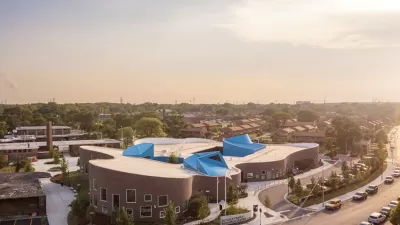Tom Sanchez and Nader Afzalan explore the age old question, "what is planning?" in their new report published earlier this week.
By analyzing self-reported research and teaching interests of faculty from Association of Collegiate Schools of Planning (ACSP) member schools, Tom Sanchez and Nader Afzalan attempted to define the practice of planning. In total, they mapped 1149 terms, with a total of 540 acting as links while the remaining 609 were considered "non-core or beyond the central cluster of planning topics."
The most common terms were planning (rank 1) and urban (rank 2). Also on the top 20 in degree rank were subjects such as policy (rank 4), environmental (rank 7), sustainable (rank 17), and international (rank 20). Another metric determined by Sanchez and Afzalan was "betweenness," which "indicates bridges or connections among nodes on the network." In the betweenness rankings, sustainable and international did not show up, but rather GIS (rank 18) and environments (rank 15).
According to the authors, "the results of this analysis suggest that the research interests of urban planning faculty are represented by a dense and cohesive core." The findings of research and teaching interests are in general agreement with APA's list of specialty planning areas. However, further research is necessary to determine whether urban planning practitioners see these topics as relevant to their professional needs.
FULL STORY: Mapping the Knowledge Domain of Planning by Tom Sanchez and Nader Afzalan

Maui's Vacation Rental Debate Turns Ugly
Verbal attacks, misinformation campaigns and fistfights plague a high-stakes debate to convert thousands of vacation rentals into long-term housing.

Planetizen Federal Action Tracker
A weekly monitor of how Trump’s orders and actions are impacting planners and planning in America.

In Urban Planning, AI Prompting Could be the New Design Thinking
Creativity has long been key to great urban design. What if we see AI as our new creative partner?

Pedestrian Deaths Drop, Remain Twice as High as in 2009
Fatalities declined by 4 percent in 2024, but the U.S. is still nowhere close to ‘Vision Zero.’

King County Supportive Housing Program Offers Hope for Unhoused Residents
The county is taking a ‘Housing First’ approach that prioritizes getting people into housing, then offering wraparound supportive services.

Researchers Use AI to Get Clearer Picture of US Housing
Analysts are using artificial intelligence to supercharge their research by allowing them to comb through data faster. Though these AI tools can be error prone, they save time and housing researchers are optimistic about the future.
Urban Design for Planners 1: Software Tools
This six-course series explores essential urban design concepts using open source software and equips planners with the tools they need to participate fully in the urban design process.
Planning for Universal Design
Learn the tools for implementing Universal Design in planning regulations.
planning NEXT
Appalachian Highlands Housing Partners
Mpact (founded as Rail~Volution)
City of Camden Redevelopment Agency
City of Astoria
City of Portland
City of Laramie





























